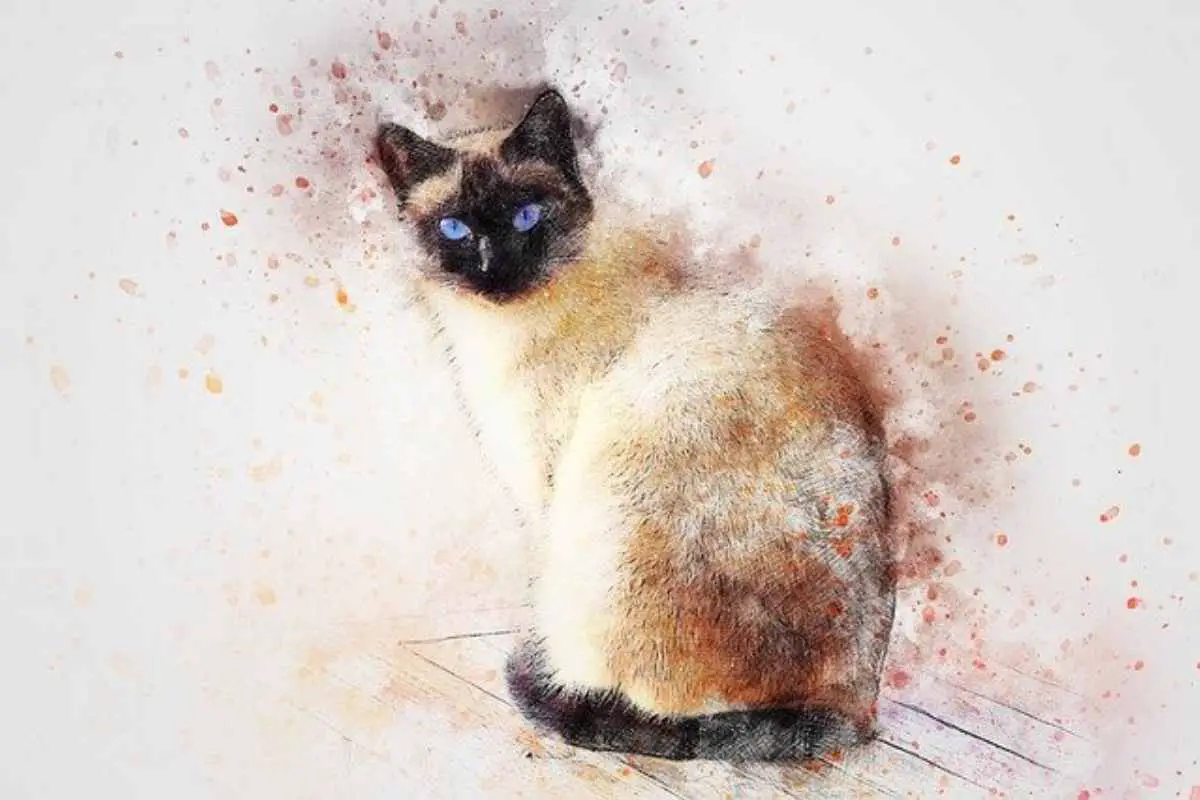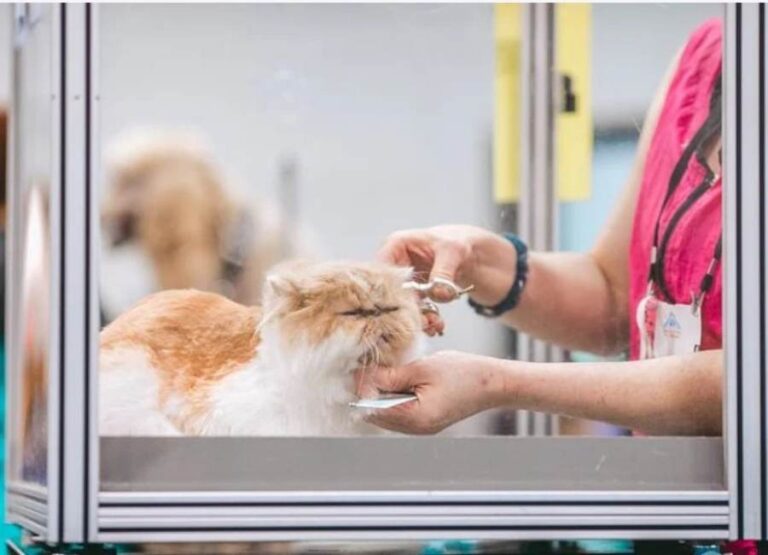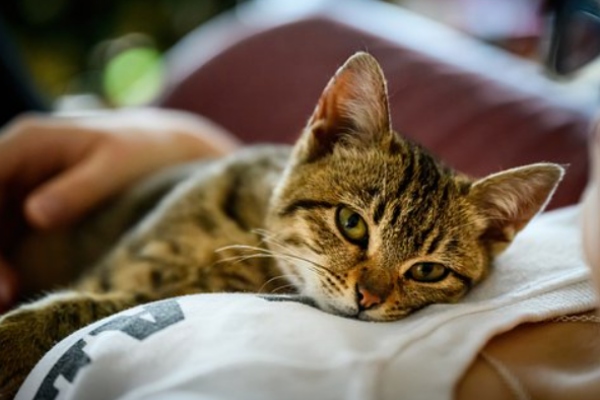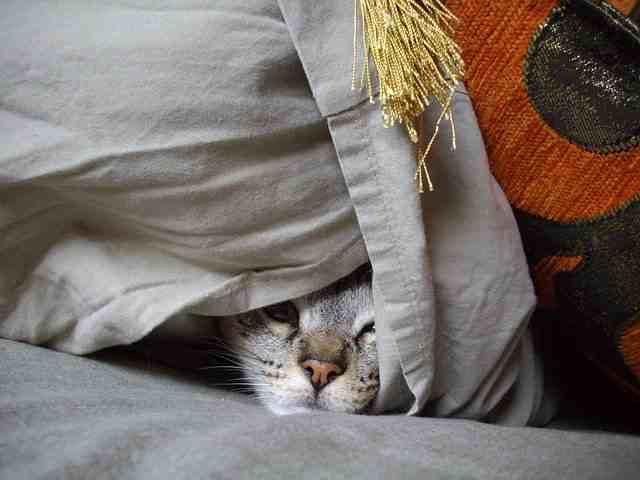Do Siamese Cats Shed: 10 Triggers & 10 Ways To Control Shedding

As a big fan of Siamese cats, I often hear owners ask do Siamese cats shed, this is an interesting question because most people say Siamese cats do not shed, but that is not true.
In this post, I will answer your question do Siamese cats shed and also outline all the common triggers that could lead to your Siamese cat shedding excessively.
People think Siamese cats do not shed because Siamese cats do shed a little when compared to other breeds of cats like Ragdoll or Maine Coons.
In reality, there are no hypoallergenic cat breeds. Although certain cat breeds generate fewer allergens than others, no cat breed is completely safe for those who are allergic to cats.
When it pertains to shedding, Siamese cats are no exception. Siamese cats, like any other cat, lose their coats as they regrow their fur.
Many Siamese owners, though, have observed that shedding is not all that apparent in Siamese cats.
Before we continue let me quickly answer your question do Siamese cats shed.
Do Siamese Cats Shed
Siamese cats, like any other cat, lose their coats as they renew their hair. However, many Siamese owners claim that the shedding is not very apparent in Siamese cats. During the fall and spring seasons, most Siamese cats shed profusely.
Nutrition, genetics, weather fluctuations, and sunshine exposure all impact how much shedding a cat produces.
Let me quickly explain what it means to be allergic to cats before we continue!
Someone who is allergic to cats is allergic to particular proteins produced by the cat. These are present in the cat’s dander, saliva, and urine.
Because all cats generate these substances, they all produce roughly the same quantity of allergies. It has absolutely nothing to do with the fur itself.
Hair’s only involvement in cat allergies is to distribute dander. A cat’s hair may often substantially distribute allergies around.
Dander, on the other hand, can move fairly far on its own and does not require hair to spread.
Siamese cats, like any other cat, lose their coats as they regrow their fur. Many Siamese owners, however, have observed that shedding is not very apparent in Siamese cats.
Read more: Can Siamese Cats Go Outside: 19 Pros and Cons To Consider
Causes of Siamese cat excessive shedding
Here are some common causes of excessive shedding in Siamese cats:
Allergies
Allergies induced by dietary or environmental factors might produce an itching response on the skin of a cat.
This can cause a Siamese cat to scratch, lick, or even bite itself. As a result, significant hair loss may occur.
Food, dust, medicine, and insect stings can all cause allergic responses in cats.
If you are concerned about excessive shedding, make an appointment with your veterinarian.
When Siamese cats come in contact with anything that they are allergic to, they shed their hair in response to their skin reaction.
This form of shedding is not seen on a regular basis, you can only notice it once in a while, and when you do, avoid contact or bringing such allergic triggers close to your cat.
Wrong Diet
A cat’s diet can cause abnormal shedding; cats can also shed owing to nutritional issues.
Siamese will shed if they do not obtain the proper balance of ingredients, which is a symptom of poor health.
Vitamins A, E, and B are critical for the production and maintenance of a healthy coat.
It is also critical to select cat food that is strong in omega-3 fatty acids. It promotes the health of the cat’s coat and reduces irritation, which can lead to excessive scratching.
Also, keep your cat hydrated at all times because it aids in overall wellness.
It is apparent from this that you must give your cat high-quality food and keep the nutrients in the diet balanced.
Always contact your vet to confirm the right food for your Siamese cat, don’t pick any random food you see online.
Stick to any food that works for you and your cat until it stops working.
Too much stress and anxiety
The most prevalent causes of unexpected and excessive shedding are when your Siamese cat undergoes too much stress or any form of anxiety.
Siamese cats are sensitive pets and respond fast to environmental changes. It doesn’t take much for them to get nervous, upset, or feel stressed.
Causes of stress in Siamese cats
- Moving to a new home
- A change in your house
- Loneliness
- Loud sounds
- A noisy setting
- Constant change of daily routine.
- Changes in food.
- A new family member.
- Another pet.
- Lack of mental stimulation, etc.
If you are going through any form of change, it is critical that you devote special attention to your Siamese during this period.
Seasonal changes
One of the most prevalent causes of your Siamese cat’s shedding is that the weather is becoming warmer due to the time of the year.
Siamese cats acquire a thicker coat to remain warm in the winter, and as the weather warms up, your Siamese cat begins to lose the excess fur.
When winter returns, you will notice that your Siamese cat begins to shed less and his hair thickens.
As a result, in the spring, Siamese will shed their winter coats in order to regulate their body temperature.
They will acquire a thicker coat in the fall to prepare for the upcoming winter. So, expect more shedding at some time of the year than other times of the year.
Read more: 10 Common Siamese Cat Behavior Problems & How To Fix Them.
The cat gender and age
It is important to note that Siamese cats do not shed as much as other cats, but as Siamese cats get older they shed more than they did at a younger age.
In a less shedding breed of cat like the Siamese cat, the loss of hair is greatly influenced by age.
Gender, like age, has an influence on how much a cat sheds, for example, a female Siamese cat who becomes pregnant will likely shed far more than male cats.
The reason for this is that when female cats become pregnant, they become stressed, and stress is a major trigger for shedding in many cats.
Parasite attacks
Fleas, a widespread pet parasite, can also cause an allergic response on your Siamese cat’s skin when they bite your Siamese cat.
When these insects bite into a Siamese cat’s skin, the cat will try to relieve the pain by licking, clawing, and biting the afflicted region this can further lead to unnecessary shedding been triggered off.
Both internal and external parasites can lead to or trigger excessive shedding in your Siamese cats.
Here are some topics about cats and parasites that are worth reading:
- How Do Indoor Cats Get Parasites.
- 17 Most Common Symptoms Of Worms In Cats You Should Know.
- How Long After Deworming a Cat Are The Worms Gone.
Hormonal changes
Hyperthyroidism is a common condition in older cats that is caused by excess release of thyroid hormone resulting in an increased metabolic state.
Excessive shedding is one of the probable side effects of this condition when this hormone called thyroid is over secreted in the body of cats.
This is more common in female cats; thus, if you own a female cat, you should be aware that she will go through physical changes, including shedding more hair than usual.
This problem of excessive shedding, however, usually resolves itself when the female cat has birth and her body returns to normalcy.
It is important to note that whenever there is a hormonal change in the cat, you should expect to see some level of shedding.
Sudden change in cat food
This type of shedding in Siamese cats is always found in cats whose owners love trying out different foods rather than sticking to what is working for them.
A change in nutrition for your Siamese cat may result in hair loss and shedding. This is more likely to occur if your cat’s diet has fewer nutrients.
If you alter your cat’s diet and discover that their hair is reacting negatively, you should consider switching back to a prior type of food.
A Siamese cat will shed more when you switch to new cat food that lacks all the needed nutrition.
Illnesses
If your Siamese cat is losing hair due to illness, you would notice that the hair is falling out in clumps more than anything else. The pattern is not the same as when your cat sheds normally.
Nonetheless, it is vital to notice since you can promptly get your cat treatment to make him feel better. Hair loss in Siamese cats can be caused or induced by a variety of illnesses.
Here are some common health challenges associated with hair loss in cats:
- Skin diseases
- Kidney disease
- Thyroid issues
- Liver conditions
- Bacterial infections
- Adrenal issues
- Fungal infections
- Cancer
Side effects of medication
Side effects of medication can only lead to unnecessary shedding if you have administered any type of drug to your cat and shortly after your cat starts shedding.
Some medicines, on the other hand, may induce itching or scaling, causing your cat to scratch and shed excessively.
Some illnesses might also cause your cat to groom herself excessively, resulting in bare areas in her fur.
Solution: Consult with a veterinarian. If your cat is shedding excessively, you should schedule an examination to rule out any health problems.
Whether your cat is already on medicine, check with your veterinarian to see if excessive shedding is a side effect.
Let’s now look at how to control excessive shedding in Siamese cats.
Read more: Do Siamese Cats Get Along With Dogs: 11 Benefits & More.
Ways to control shedding in Siamese cats
Here are some common ways to reduce, control or stop excessive shedding in Siamese cats:
Avoid parasite infestations in your Siamese cat
Fleas, ticks, and other parasites will not only make your Siamese cat unhappy, but they will also damage the quality of their coat.
If scratched often, flea bites can cause significant hair loss as well as unpleasant and inflamed skin.
Schedule a consultation with your veterinarian to explore effective flea and tick management alternatives.
Here are some of the most frequent ways your Siamese cat might become infected with worms or other parasites:
- Ingesting fleas can cause worms in Siamese.
- A mosquito bite can cause worms in Siamese (heartworm).
- Siamese may become worm-infected by eating a worm-infected mouse.
- Unkept litter boxes can provide worms to Siamese.
- When pursuing an infected mouse, Siamese can pick up worms.
- Siamese may become worm-infected by ingesting worm larvae.
- Worms may infect Siamese via unkempt human footwear.
- Siamese may pick up worms from potted plants around the house.
- Worms may be obtained by Siamese from neglected little flower beds.
Provide high-quality food for your Siamese cat
Keep a watch on what your Siamese cat eats. In all pets, a well-balanced diet promotes healthy skin and minimizes shedding.
A Siamese cat needs a nutritious, well-balanced cat diet. Your cat’s coat condition is primarily affected by how well you feed it.
Feed a well-balanced food to your Siamese cat. This allows her to keep even little hair shedding on the inside to a bare minimum.
If she consumes a cat food heavy in Omega-3 fatty acids, oils, and minerals, her hair and skin will be as smooth and healthy as possible.
Consult your veterinarian before changing your Siamese cat’s food.
Keep your Siamese cat’s body temperature low at all times
Because shedding is facilitated by a warm environment, your Siamese cat will shed more frequently if you have central heating.
This is due to the fact that its coat will make it look as though it is summer when it is not.
Are you aware that temperature has a big influence on sudden color changes in cats? This has an indirect influence on the shedding of your Siamese cat.
As a result, if you want to reduce shedding, don’t expose your Siamese cat to temperatures exceeding 25-30.8° C.
Don’t expose your Siamese cat to high temperature for any reason as it can trigger off unnecessary shedding.
Avoid any Siamese cat allergies
Addressing allergies is one of the most essential things you can do to protect your Siamese cat from shedding excessively.
A variety of factors can cause allergic responses in Siamese cats. Pollen, mold spores, dust mites, and lost skin cells are all frequent allergens.
Food allergies might manifest themselves in the form of skin disorders or hair loss in your Siamese cat, so keep an eye out for skin and hair issues.
Symptoms of a Siamese cat’s allergic response
Here are some common indicators that your Siamese cat is allergic to particular foods or materials:
- Sneezing on a regular basis.
- Continues to vomit.
- Eyes that are running.
- Ears that itch.
- Nose is running.
- Licking on a regular basis.
- Diarrhea as usual.
- Face swollen.
- Chewing on the skin.
Avoid dehydration
Water should always be available to Siamese cats. This is important because cats with little water intake have dry skin and hair, which causes excessive molting.
Keeping your cat’s water bowl clean and filled lowers the risk of harmful bacteria being ingested.
Always check your Siamese cat water bowls to make sure they’re drinking only clean water. Dehydration can cause unnecessary health challenges, not just shedding.
Reduce your Siamese cat anxiety and stress levels
If your cat is frightened or disturbed, it will lose more fur than usual. They may also groom themselves excessively, resulting in bald patches or skin irritation.
Avoid all forms of stress since it might promote excessive shedding in Siamese cats.
Here are some things to do to avoid stress in Siamese cats:
- Avoid unnecessary changing of food.
- Avoid loud sounds or noises.
- Stop changing your daily routine.
- Don’t shout at your cat
- Stop changing meal time, etc.
Give your Siamese cat no table leftovers or stale food
Siamese cats may have stomach pain and excessive shedding as a result of eating table scraps.
Do you know that sweeping up table crumbs on the floor might cause a bacterial illness in your Siamese cat?
It is not a good idea to let your Siamese cat eat on the ground; instead, feed your Siamese cat from a clean container.
When you’re eating, don’t let your Siamese cats drag stuff off the table, and if they do, don’t let them.
Siamese cats’ stomachs are delicate, and they may vomit if they eat stale food or table scraps.
Brushing decreases shedding
Brushing your cat hair in the direction of growth on a weekly basis will help remove extra undercoats and minimize shedding.
Brushing your cat’s hair once a week can also assist to prevent excessive shedding and can help identification of skin diseases or fleas, which can lead to more shedding.
Brush in the direction of hair growth using a slicker brush, pin brush, or comb with wide-set bristles where the cat appears comfortable, and you should see a difference in less than a month.
It is advised that you brush your Siamese cat’s fur on a regular basis. Make a weekly session with your cat a priority if that isn’t possible.
You should also make an effort to form good connections and attempt to reward yourself at the end of each grooming session.
Maintain regular hygienic practices
Cleaning habits are only a preventive strategy to help Siamese cats avoid excessive shedding.
To keep your Siamese cat from shedding, use these hygiene tips:
- Ensure that your Siamese cat has access to clean water at all times.
- It’s important to replace the water in your Siamese cat’s bowl on a frequent basis.
- It’s critical to keep your Siamese cat’s eating dishes clean.
- Removing your shoes prevents your Siamese cat from being ill from worms since the footwear is unkept.
- Allowing your Siamese cat to use dirty litter boxes is not a smart idea.
- Keeping your home’s floor clean.
- Keeping your Siamese cat’s long-term waste out of reach.
Make medical appointments on a regular basis
This is a crucial step to follow when it comes to how to keep Siamese cats from shedding since they may shed for a number of reasons.
Always get medical advice from a veterinarian and have your Siamese cat examined on a regular basis.
Shedding has been related to a number of health problems, including:
- Cancer
- Liver conditions
- Kidney disease
- Thyroid issues
- Bacterial infections
- Fungal infections
All the above can be identified and fixed if you always seek or visit a veterinarian once in a while.
References:

![Why Does My Cat Smell So Bad [12 Potential Reasons] Why Does My Cat Smell So Bad](https://petcreeks.com/wp-content/uploads/2023/10/cat-3054260_640.jpg)



![Why Is My Kitten Drinking So Much Water [9 Reasons] Why Is My Kitten Drinking So Much Water](https://petcreeks.com/wp-content/uploads/2023/12/pexels-helena-jankovicova-kovacova-16440316.jpg)
